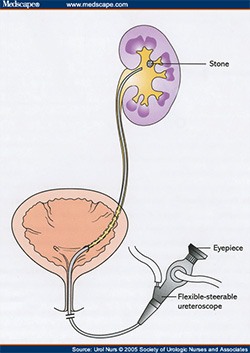Holmium Laser Stone Surgery using Flexible Pyelo- Ureteroscopy

What is it?
Flexible pyeloscopy (or Retrograde Intra Renal Surgery- RIRS) is where a thin lighted telescope is introduced into the kidney from outside the patients without the need for any incision (see diagram). The diameter of the instrument is 2.5mm and allows visualisation of the entire kidney and the ureter due to the flexible nature of the scope. It contains a small instrument port which allows the introduction of a holmium laser fibre (0.2 mm diameter) to efficiently fragment stones, and micro-baskets (less than 1mm wide) to retrieve any stone fragments. Kidney stones up to 2cm in size can be treated using this approach.
What are the main advantages of this approach?
- Allows stone treatment without the need for any incision by using the urethra as the entry point
- Has a very high degree of success in treating stones
- Can be performed as day surgery
What are the main disadvantages?
- More invasive compared with shock wave lithotripsy
- General anaesthetic required
- Small risk of damage to ureter (0.5%)
What preparation is required?
As the procedure is performed under general anaesthesia, you should have nothing to eat or drink for 6 hours prior to treatment. Regular medications can be taken with a sip of water with the exception of blood thinning agents (eg. warfarin, aspirin, clopidogrel) or non-steroidal anti-inflammatories which may need to be stopped beforehand. Your doctor will advise you about your specific circumstances. A mid stream urine (MSU) test is required to ensure the urine is sterile before treatment is undertaken.
What do I need to bring to surgery?
- All related imaging such as x-rays, CT scan or ultrasound
- Your usual medications
What happens in the operating room?
You will meet your anaesthetist prior to surgery who will take a thorough medical history. This person will be responsible for your safety whilst you are under general anaesthesia. The procedure will usually take 60 to 90 minutes and involves putting a flexible telescope into the drainage tube of the kidney and fragmenting the stone(s) with a holmium laser. A temporary double J ureteric stent may be left in place for a short period to ensure the kidney drains without risk of blockage.
What are the risks?
This is generally considered a very safe operation. Specific risks to surgery include: infection, minor bleeding, and perforation of the ureter (1 in 200).
What to expect afterwards?
It is normal to feel the need to pass urine frequently and notice blood in the urine following surgery. This will settle over the ensuing days. An oral over the counter medication called Ural can reduce the stinging sensation during urination. You will sometimes have a temporary ureteric stent(see stent info sheet) following surgery which allows the stone fragments to drain unimpeded. The stent maybe attached to a string tether coming out from the urethra which allows easy removal in the doctor’s office. Care needs to be taken so as not to accidently dislodge the stent by allowing it to get caught up on your underwear.
Follow-up
You will be advised after surgery the necessary follow-up arrangements. A script for oral antibiotics will need to be taken for 5 days to prevent infection. You need to drink at least 8 glasses of water a day (2.5L/day). Simple analgesics such as Panadol and Nurofen are usually all that is required, occasionally stronger medication (eg. Panadeine Forte) may be necessary. You will not be able to drive for at least 24 hours after surgery as you have had a general anaesthetic.
- Click here to download Holmium Laser Stone Surgery using Flexible Pyelo- Ureteroscopy info sheet.
You will need the Adobe Reader to view and print these documents.![]()





 Menu
Menu


